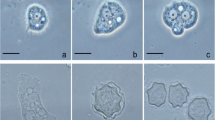Abstract
The translation elongation factor-1 alpha (EF-1α) gene was used to examine the phylogenetic relationships among 30 previously characterized isolates representing ten North American Armillaria species: A. solidipes (=A. ostoyae), A. gemina, A. calvescens, A. sinapina, A. mellea, A. gallica, A. nabsnona, North American biological species X, A. cepistipes, and A. tabescens. The phylogenetic relationships revealed clear separation of all ten North American Armillaria species, with the exception of one A. gallica isolate that perhaps represents an unnamed cryptic species. These results indicate that the EF-1α gene could potentially serve as a diagnostic tool for distinguishing among currently recognized North American biological species of Armillaria.

Similar content being viewed by others
References
Akaike H (1974) A new look at the statistical model identification. IEEE Trans Automat Control 19:716–723
Anderson JB, Stasovski E (1992) Molecular phylogeny of northern hemisphere species of Armillaria. Mycologia 84:505–516
Anderson JB, Ullrich RC (1979) Biological species of Armillaria mellea in North America. Mycologia 71:402–414
Baumgartner K, Travadon R, Bruhn J, Bergemann SE (2010) Contrasting patterns of genetic diversity and population structure of Armillaria mellea sensu stricto in the eastern and western United States. Phytopathology 100:708–718
Burdsall HH Jr, Volk TJ (2008) Armillaria solidipes, an older name for the fungus called Armillaria ostoyae. N Am Fungi 3:261–267
Dettman JR, van der Kamp BJ (2001) The population structure of Armillaria ostoyae and Armillaria sinapina in the central interior of British Columbia. Can J Bot 79:600–611
Felsenstein J (1981) Evolutionary trees from DNA sequences: a maximum likelihood approach. J Mol Evol 17:368–376
Guindon S, Gascuel O (2003) A simple, fast, and accurate algorithm to estimate large phylogenies by maximum likelihood. Syst Biol 52:696–704
Hall TA (1999) BioEdit: a user-friendly biological sequence alignment editor and analysis program for Windows 95/98/NT. Nucleic Acids Symp Ser 41:95–98
Hanna JW, Klopfenstein NB, Kim M-S, McDonald GI, Moore JA (2007) Phylogeographic patterns of Armillaria ostoyae in the western United States. For Pathol 37:192–216
Harrington TC, Wingfield BD (1995) A PCR-based identification method for species of Armillaria. Mycologia 87:280–288
Hasegawa E, Ota Y, Hattori T, Kikuchi T (2010) Sequence-based identification of Japanese Armillaria species using the elongation factor-1 alpha gene. Mycologia 102:898–910
Hawksworth DL (2010) Cryptic speciation: how common is it and how should it be handled taxonomically? http://imc9.info/prog_sig3_detail_hawksworth.htm
Kauserud H, Schumacher T (2001) Outcrossing or inbreeding: DNA markers provide evidence for type of reproductive mode in Phellinus nigrolimitatus (Basidiomycota). Mycol Res 105:676–683
Kim M-S, Klopfenstein NB, McDonald GI, Arumuganathan K, Vidaver AK (2000) Characterization of North American Armillaria species by nuclear DNA content and RFLP analysis. Mycologia 92:874–883
Kim M-S, Klopfenstein NB, Hanna JW, McDonald GI (2006) Characterization of North American Armillaria species: genetic relationships determined by ribosomal DNA sequences and AFLP markers. For Pathol 36:145–164
Maphosa L, Wingfield BD, Coetzee MPA, Mwenje E, Wingfield MJ (2006) Phylogenetic relationships among Armillaria species inferred from partial elongation factor 1-alpha DNA sequence data. Aust Plant Pathol 35:513–520
McLaughlin JA, Hsiang T (2010) Identification protocol for six Armillaria species from northeastern North America. Can J For Res 40:536–548
Morrison DJ, Chu D, Johnson ALS (1985) Species of Armillaria in British Columbia. Can J Plant Pathol 7:242–246
Piercey-Normore MD, Egger KN, Bérubé JA (1998) Molecular phylogeny and evolutionary divergence of North American biological species of Armillaria. Mol Phylogenet Evol 10:49–66
Posada D (2008) jModelTest: phylogenetic model averaging. Mol Biol Evol 25:1253–1256
Rehner SA, Buckley E (2005) A Beauveria phylogeny inferred from nuclear ITS and EF1-α sequences: evidence for cryptic diversification and links to Cordyceps teleomorphs. Mycologia 97:84–98
Ronquist F, Huelsenbeck JP (2003) MRBAYES 3: Bayesian phylogenetic inference under mixed models. Bioinformatics 19:1572–1574
Schnabel G, Ash JS, Bryson PK (2005) Identification and characterization of Armillaria tabescens from the southeastern United States. Mycol Res 109:1208–1222
Simmons MP, Ochoterena H (2000) Gaps as characters in sequence-based phylogenetic analyses. Syst Biol 49:369–381
Volk TJ, Burdsall HH Jr (1995) A nomenclatural study of Armillaria and Armillariella species. Synop Fungorum 8:1–121
Volk TJ, Burdsall HH Jr, Banik MT (1996) Armillaria nabsnona, a new species from western North America. Mycologia 88:484–491
White EE, Dubetz CP, Cruickshank MG, Morrison DJ (1998) DNA diagnostic for Armillaria species in British Columbia: within and between species variation in the IGS-1 and IGS-2 regions. Mycologia 90:125–131
Acknowledgments
The project was supported by USDA Forest Service-RMRS, Forest and Woodland Ecosystems Program, Research Joint Venture Agreement (07-JV-11221662-285), and the Special Technology Development Program of the USDA Forest Service, S&PF Forest Health Monitoring.
Author information
Authors and Affiliations
Corresponding author
About this article
Cite this article
Ross-Davis, A.L., Hanna, J.W., Kim, MS. et al. Advances toward DNA-based identification and phylogeny of North American Armillaria species using elongation factor-1 alpha gene. Mycoscience 53, 161–165 (2012). https://doi.org/10.1007/s10267-011-0148-x
Received:
Accepted:
Published:
Issue Date:
DOI: https://doi.org/10.1007/s10267-011-0148-x




